IBU5HRM La Trobe University: Analyzing HRM in a Global Economy
VerifiedAdded on 2023/06/12
|14
|3278
|428
Essay
AI Summary
This essay critically evaluates human resource management factors within the context of "No Name" aircraft, an organization headquartered in Australia with subsidiaries in Singapore, China, and Vietnam. It focuses on cultural diversity, performance management, and training and development. The essay examines the lack of cultural integration, communication gaps, and limited performance appraisal practices across the organization's international locations. It emphasizes the importance of diversity management, performance management, and relevant training programs to enhance employee skills and organizational objectives. Recommendations include adopting on-the-job training, promoting social learning, framing inclusive disability policies, and encouraging senior managers to foster innovation to improve overall productivity and effectiveness. The analysis underscores the interconnectedness of these HRM functions in achieving organizational success.
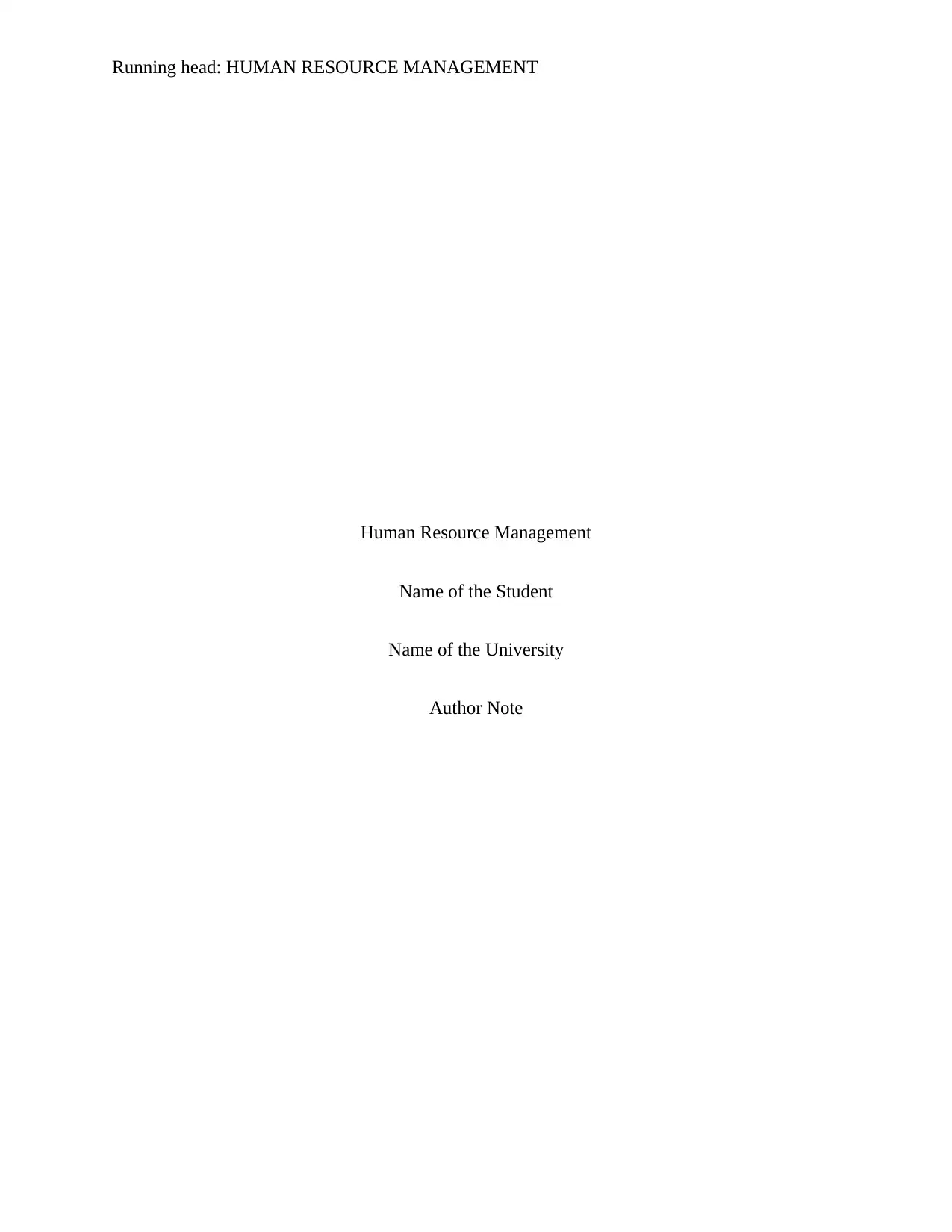
Running head: HUMAN RESOURCE MANAGEMENT
Human Resource Management
Name of the Student
Name of the University
Author Note
Human Resource Management
Name of the Student
Name of the University
Author Note
Paraphrase This Document
Need a fresh take? Get an instant paraphrase of this document with our AI Paraphraser
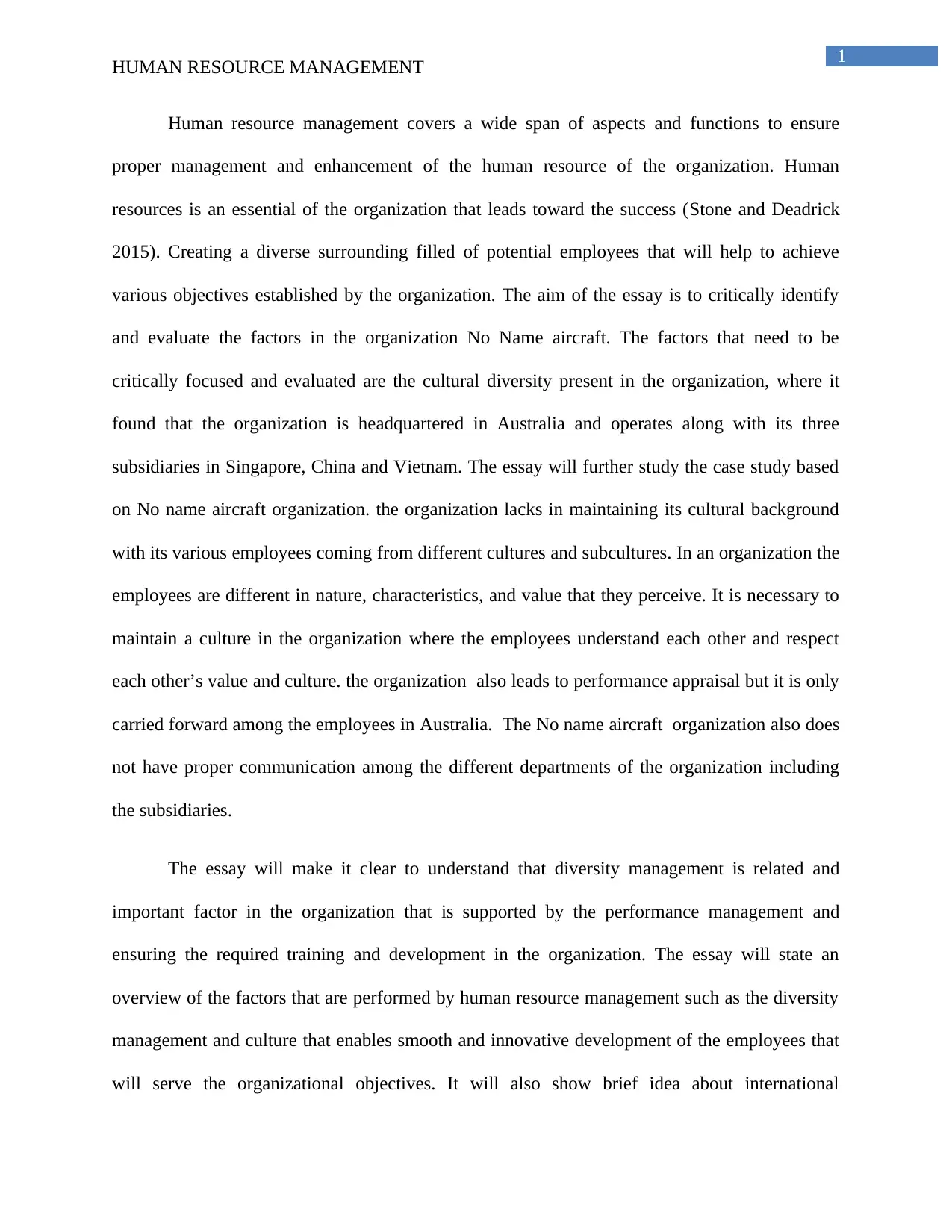
1
HUMAN RESOURCE MANAGEMENT
Human resource management covers a wide span of aspects and functions to ensure
proper management and enhancement of the human resource of the organization. Human
resources is an essential of the organization that leads toward the success (Stone and Deadrick
2015). Creating a diverse surrounding filled of potential employees that will help to achieve
various objectives established by the organization. The aim of the essay is to critically identify
and evaluate the factors in the organization No Name aircraft. The factors that need to be
critically focused and evaluated are the cultural diversity present in the organization, where it
found that the organization is headquartered in Australia and operates along with its three
subsidiaries in Singapore, China and Vietnam. The essay will further study the case study based
on No name aircraft organization. the organization lacks in maintaining its cultural background
with its various employees coming from different cultures and subcultures. In an organization the
employees are different in nature, characteristics, and value that they perceive. It is necessary to
maintain a culture in the organization where the employees understand each other and respect
each other’s value and culture. the organization also leads to performance appraisal but it is only
carried forward among the employees in Australia. The No name aircraft organization also does
not have proper communication among the different departments of the organization including
the subsidiaries.
The essay will make it clear to understand that diversity management is related and
important factor in the organization that is supported by the performance management and
ensuring the required training and development in the organization. The essay will state an
overview of the factors that are performed by human resource management such as the diversity
management and culture that enables smooth and innovative development of the employees that
will serve the organizational objectives. It will also show brief idea about international
HUMAN RESOURCE MANAGEMENT
Human resource management covers a wide span of aspects and functions to ensure
proper management and enhancement of the human resource of the organization. Human
resources is an essential of the organization that leads toward the success (Stone and Deadrick
2015). Creating a diverse surrounding filled of potential employees that will help to achieve
various objectives established by the organization. The aim of the essay is to critically identify
and evaluate the factors in the organization No Name aircraft. The factors that need to be
critically focused and evaluated are the cultural diversity present in the organization, where it
found that the organization is headquartered in Australia and operates along with its three
subsidiaries in Singapore, China and Vietnam. The essay will further study the case study based
on No name aircraft organization. the organization lacks in maintaining its cultural background
with its various employees coming from different cultures and subcultures. In an organization the
employees are different in nature, characteristics, and value that they perceive. It is necessary to
maintain a culture in the organization where the employees understand each other and respect
each other’s value and culture. the organization also leads to performance appraisal but it is only
carried forward among the employees in Australia. The No name aircraft organization also does
not have proper communication among the different departments of the organization including
the subsidiaries.
The essay will make it clear to understand that diversity management is related and
important factor in the organization that is supported by the performance management and
ensuring the required training and development in the organization. The essay will state an
overview of the factors that are performed by human resource management such as the diversity
management and culture that enables smooth and innovative development of the employees that
will serve the organizational objectives. It will also show brief idea about international
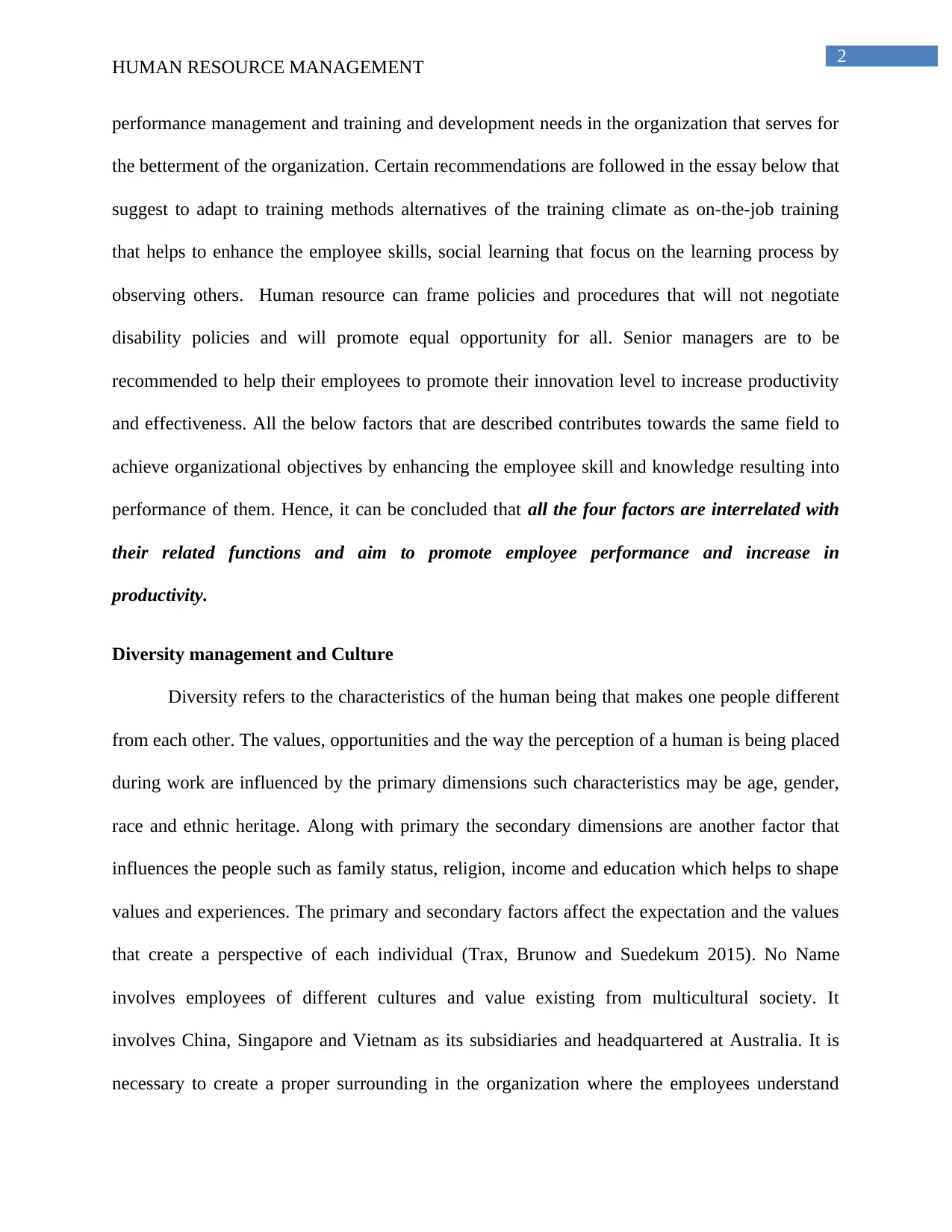
2
HUMAN RESOURCE MANAGEMENT
performance management and training and development needs in the organization that serves for
the betterment of the organization. Certain recommendations are followed in the essay below that
suggest to adapt to training methods alternatives of the training climate as on-the-job training
that helps to enhance the employee skills, social learning that focus on the learning process by
observing others. Human resource can frame policies and procedures that will not negotiate
disability policies and will promote equal opportunity for all. Senior managers are to be
recommended to help their employees to promote their innovation level to increase productivity
and effectiveness. All the below factors that are described contributes towards the same field to
achieve organizational objectives by enhancing the employee skill and knowledge resulting into
performance of them. Hence, it can be concluded that all the four factors are interrelated with
their related functions and aim to promote employee performance and increase in
productivity.
Diversity management and Culture
Diversity refers to the characteristics of the human being that makes one people different
from each other. The values, opportunities and the way the perception of a human is being placed
during work are influenced by the primary dimensions such characteristics may be age, gender,
race and ethnic heritage. Along with primary the secondary dimensions are another factor that
influences the people such as family status, religion, income and education which helps to shape
values and experiences. The primary and secondary factors affect the expectation and the values
that create a perspective of each individual (Trax, Brunow and Suedekum 2015). No Name
involves employees of different cultures and value existing from multicultural society. It
involves China, Singapore and Vietnam as its subsidiaries and headquartered at Australia. It is
necessary to create a proper surrounding in the organization where the employees understand
HUMAN RESOURCE MANAGEMENT
performance management and training and development needs in the organization that serves for
the betterment of the organization. Certain recommendations are followed in the essay below that
suggest to adapt to training methods alternatives of the training climate as on-the-job training
that helps to enhance the employee skills, social learning that focus on the learning process by
observing others. Human resource can frame policies and procedures that will not negotiate
disability policies and will promote equal opportunity for all. Senior managers are to be
recommended to help their employees to promote their innovation level to increase productivity
and effectiveness. All the below factors that are described contributes towards the same field to
achieve organizational objectives by enhancing the employee skill and knowledge resulting into
performance of them. Hence, it can be concluded that all the four factors are interrelated with
their related functions and aim to promote employee performance and increase in
productivity.
Diversity management and Culture
Diversity refers to the characteristics of the human being that makes one people different
from each other. The values, opportunities and the way the perception of a human is being placed
during work are influenced by the primary dimensions such characteristics may be age, gender,
race and ethnic heritage. Along with primary the secondary dimensions are another factor that
influences the people such as family status, religion, income and education which helps to shape
values and experiences. The primary and secondary factors affect the expectation and the values
that create a perspective of each individual (Trax, Brunow and Suedekum 2015). No Name
involves employees of different cultures and value existing from multicultural society. It
involves China, Singapore and Vietnam as its subsidiaries and headquartered at Australia. It is
necessary to create a proper surrounding in the organization where the employees understand
⊘ This is a preview!⊘
Do you want full access?
Subscribe today to unlock all pages.

Trusted by 1+ million students worldwide
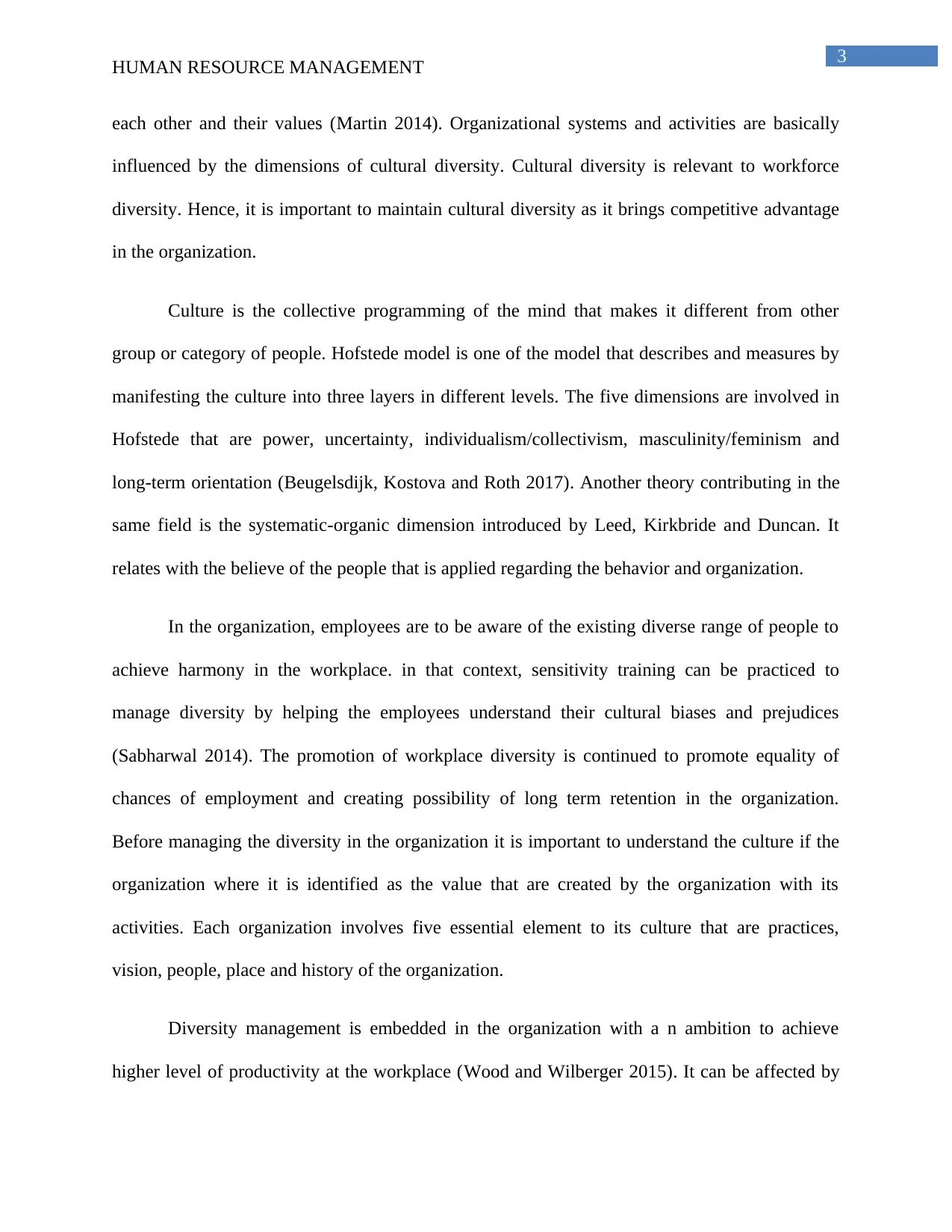
3
HUMAN RESOURCE MANAGEMENT
each other and their values (Martin 2014). Organizational systems and activities are basically
influenced by the dimensions of cultural diversity. Cultural diversity is relevant to workforce
diversity. Hence, it is important to maintain cultural diversity as it brings competitive advantage
in the organization.
Culture is the collective programming of the mind that makes it different from other
group or category of people. Hofstede model is one of the model that describes and measures by
manifesting the culture into three layers in different levels. The five dimensions are involved in
Hofstede that are power, uncertainty, individualism/collectivism, masculinity/feminism and
long-term orientation (Beugelsdijk, Kostova and Roth 2017). Another theory contributing in the
same field is the systematic-organic dimension introduced by Leed, Kirkbride and Duncan. It
relates with the believe of the people that is applied regarding the behavior and organization.
In the organization, employees are to be aware of the existing diverse range of people to
achieve harmony in the workplace. in that context, sensitivity training can be practiced to
manage diversity by helping the employees understand their cultural biases and prejudices
(Sabharwal 2014). The promotion of workplace diversity is continued to promote equality of
chances of employment and creating possibility of long term retention in the organization.
Before managing the diversity in the organization it is important to understand the culture if the
organization where it is identified as the value that are created by the organization with its
activities. Each organization involves five essential element to its culture that are practices,
vision, people, place and history of the organization.
Diversity management is embedded in the organization with a n ambition to achieve
higher level of productivity at the workplace (Wood and Wilberger 2015). It can be affected by
HUMAN RESOURCE MANAGEMENT
each other and their values (Martin 2014). Organizational systems and activities are basically
influenced by the dimensions of cultural diversity. Cultural diversity is relevant to workforce
diversity. Hence, it is important to maintain cultural diversity as it brings competitive advantage
in the organization.
Culture is the collective programming of the mind that makes it different from other
group or category of people. Hofstede model is one of the model that describes and measures by
manifesting the culture into three layers in different levels. The five dimensions are involved in
Hofstede that are power, uncertainty, individualism/collectivism, masculinity/feminism and
long-term orientation (Beugelsdijk, Kostova and Roth 2017). Another theory contributing in the
same field is the systematic-organic dimension introduced by Leed, Kirkbride and Duncan. It
relates with the believe of the people that is applied regarding the behavior and organization.
In the organization, employees are to be aware of the existing diverse range of people to
achieve harmony in the workplace. in that context, sensitivity training can be practiced to
manage diversity by helping the employees understand their cultural biases and prejudices
(Sabharwal 2014). The promotion of workplace diversity is continued to promote equality of
chances of employment and creating possibility of long term retention in the organization.
Before managing the diversity in the organization it is important to understand the culture if the
organization where it is identified as the value that are created by the organization with its
activities. Each organization involves five essential element to its culture that are practices,
vision, people, place and history of the organization.
Diversity management is embedded in the organization with a n ambition to achieve
higher level of productivity at the workplace (Wood and Wilberger 2015). It can be affected by
Paraphrase This Document
Need a fresh take? Get an instant paraphrase of this document with our AI Paraphraser
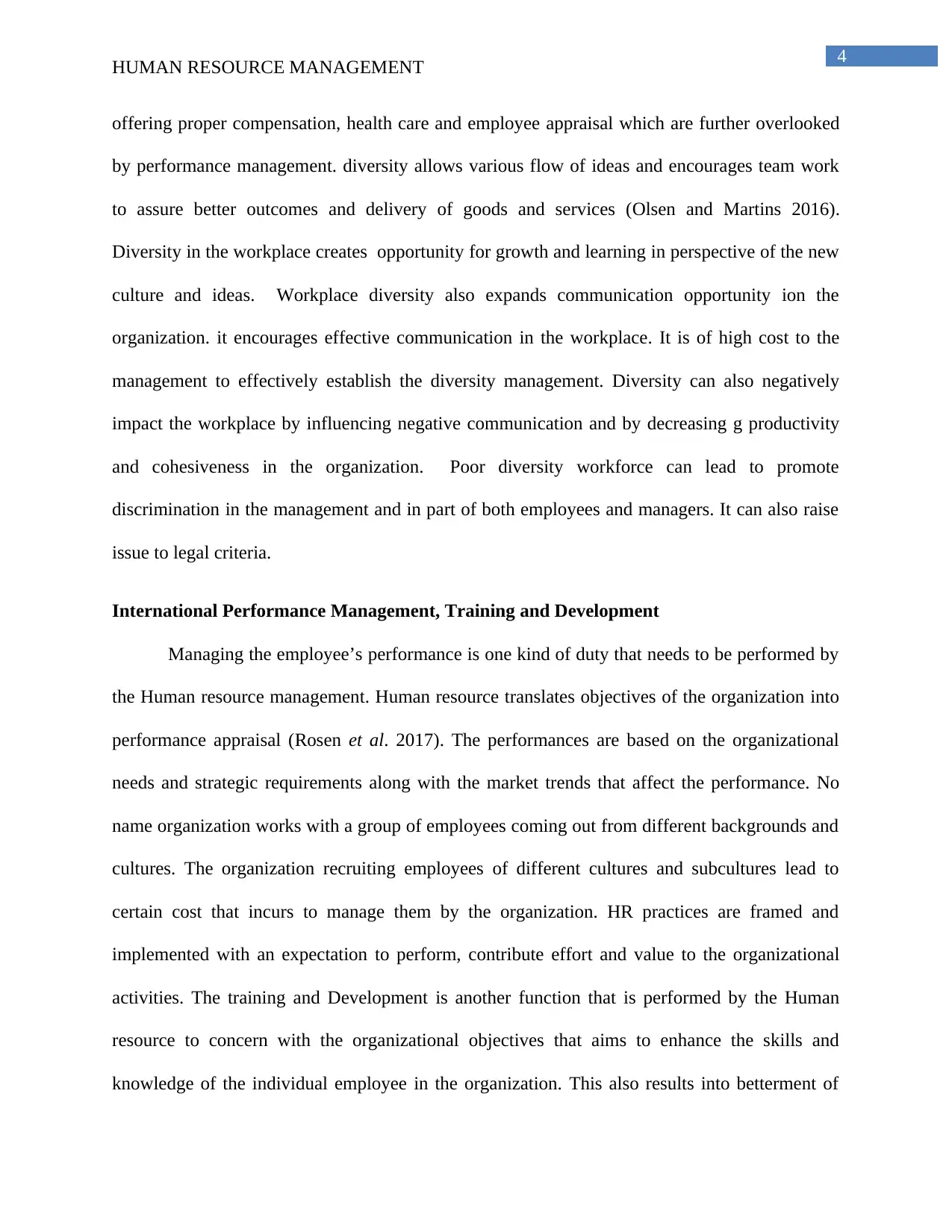
4
HUMAN RESOURCE MANAGEMENT
offering proper compensation, health care and employee appraisal which are further overlooked
by performance management. diversity allows various flow of ideas and encourages team work
to assure better outcomes and delivery of goods and services (Olsen and Martins 2016).
Diversity in the workplace creates opportunity for growth and learning in perspective of the new
culture and ideas. Workplace diversity also expands communication opportunity ion the
organization. it encourages effective communication in the workplace. It is of high cost to the
management to effectively establish the diversity management. Diversity can also negatively
impact the workplace by influencing negative communication and by decreasing g productivity
and cohesiveness in the organization. Poor diversity workforce can lead to promote
discrimination in the management and in part of both employees and managers. It can also raise
issue to legal criteria.
International Performance Management, Training and Development
Managing the employee’s performance is one kind of duty that needs to be performed by
the Human resource management. Human resource translates objectives of the organization into
performance appraisal (Rosen et al. 2017). The performances are based on the organizational
needs and strategic requirements along with the market trends that affect the performance. No
name organization works with a group of employees coming out from different backgrounds and
cultures. The organization recruiting employees of different cultures and subcultures lead to
certain cost that incurs to manage them by the organization. HR practices are framed and
implemented with an expectation to perform, contribute effort and value to the organizational
activities. The training and Development is another function that is performed by the Human
resource to concern with the organizational objectives that aims to enhance the skills and
knowledge of the individual employee in the organization. This also results into betterment of
HUMAN RESOURCE MANAGEMENT
offering proper compensation, health care and employee appraisal which are further overlooked
by performance management. diversity allows various flow of ideas and encourages team work
to assure better outcomes and delivery of goods and services (Olsen and Martins 2016).
Diversity in the workplace creates opportunity for growth and learning in perspective of the new
culture and ideas. Workplace diversity also expands communication opportunity ion the
organization. it encourages effective communication in the workplace. It is of high cost to the
management to effectively establish the diversity management. Diversity can also negatively
impact the workplace by influencing negative communication and by decreasing g productivity
and cohesiveness in the organization. Poor diversity workforce can lead to promote
discrimination in the management and in part of both employees and managers. It can also raise
issue to legal criteria.
International Performance Management, Training and Development
Managing the employee’s performance is one kind of duty that needs to be performed by
the Human resource management. Human resource translates objectives of the organization into
performance appraisal (Rosen et al. 2017). The performances are based on the organizational
needs and strategic requirements along with the market trends that affect the performance. No
name organization works with a group of employees coming out from different backgrounds and
cultures. The organization recruiting employees of different cultures and subcultures lead to
certain cost that incurs to manage them by the organization. HR practices are framed and
implemented with an expectation to perform, contribute effort and value to the organizational
activities. The training and Development is another function that is performed by the Human
resource to concern with the organizational objectives that aims to enhance the skills and
knowledge of the individual employee in the organization. This also results into betterment of
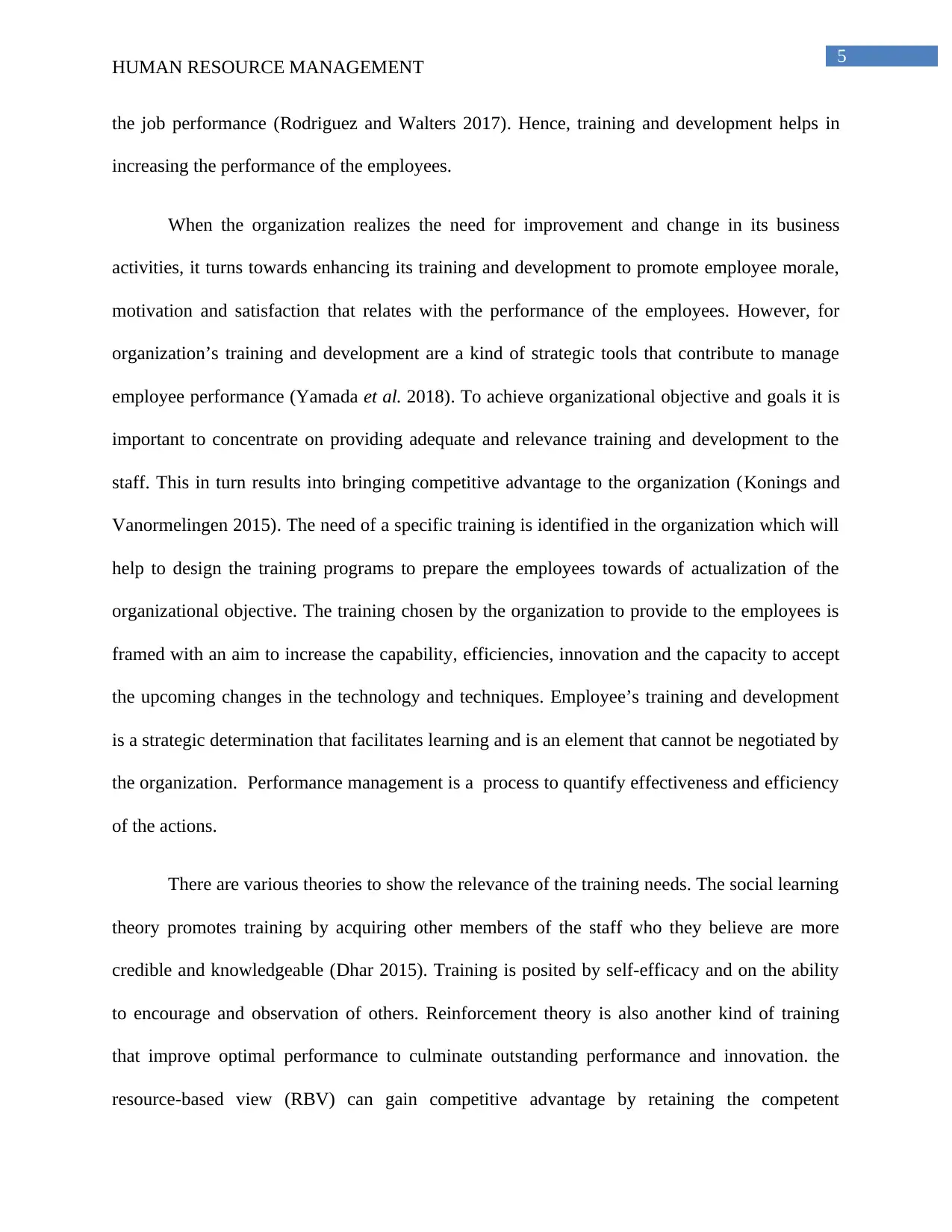
5
HUMAN RESOURCE MANAGEMENT
the job performance (Rodriguez and Walters 2017). Hence, training and development helps in
increasing the performance of the employees.
When the organization realizes the need for improvement and change in its business
activities, it turns towards enhancing its training and development to promote employee morale,
motivation and satisfaction that relates with the performance of the employees. However, for
organization’s training and development are a kind of strategic tools that contribute to manage
employee performance (Yamada et al. 2018). To achieve organizational objective and goals it is
important to concentrate on providing adequate and relevance training and development to the
staff. This in turn results into bringing competitive advantage to the organization (Konings and
Vanormelingen 2015). The need of a specific training is identified in the organization which will
help to design the training programs to prepare the employees towards of actualization of the
organizational objective. The training chosen by the organization to provide to the employees is
framed with an aim to increase the capability, efficiencies, innovation and the capacity to accept
the upcoming changes in the technology and techniques. Employee’s training and development
is a strategic determination that facilitates learning and is an element that cannot be negotiated by
the organization. Performance management is a process to quantify effectiveness and efficiency
of the actions.
There are various theories to show the relevance of the training needs. The social learning
theory promotes training by acquiring other members of the staff who they believe are more
credible and knowledgeable (Dhar 2015). Training is posited by self-efficacy and on the ability
to encourage and observation of others. Reinforcement theory is also another kind of training
that improve optimal performance to culminate outstanding performance and innovation. the
resource-based view (RBV) can gain competitive advantage by retaining the competent
HUMAN RESOURCE MANAGEMENT
the job performance (Rodriguez and Walters 2017). Hence, training and development helps in
increasing the performance of the employees.
When the organization realizes the need for improvement and change in its business
activities, it turns towards enhancing its training and development to promote employee morale,
motivation and satisfaction that relates with the performance of the employees. However, for
organization’s training and development are a kind of strategic tools that contribute to manage
employee performance (Yamada et al. 2018). To achieve organizational objective and goals it is
important to concentrate on providing adequate and relevance training and development to the
staff. This in turn results into bringing competitive advantage to the organization (Konings and
Vanormelingen 2015). The need of a specific training is identified in the organization which will
help to design the training programs to prepare the employees towards of actualization of the
organizational objective. The training chosen by the organization to provide to the employees is
framed with an aim to increase the capability, efficiencies, innovation and the capacity to accept
the upcoming changes in the technology and techniques. Employee’s training and development
is a strategic determination that facilitates learning and is an element that cannot be negotiated by
the organization. Performance management is a process to quantify effectiveness and efficiency
of the actions.
There are various theories to show the relevance of the training needs. The social learning
theory promotes training by acquiring other members of the staff who they believe are more
credible and knowledgeable (Dhar 2015). Training is posited by self-efficacy and on the ability
to encourage and observation of others. Reinforcement theory is also another kind of training
that improve optimal performance to culminate outstanding performance and innovation. the
resource-based view (RBV) can gain competitive advantage by retaining the competent
⊘ This is a preview!⊘
Do you want full access?
Subscribe today to unlock all pages.

Trusted by 1+ million students worldwide
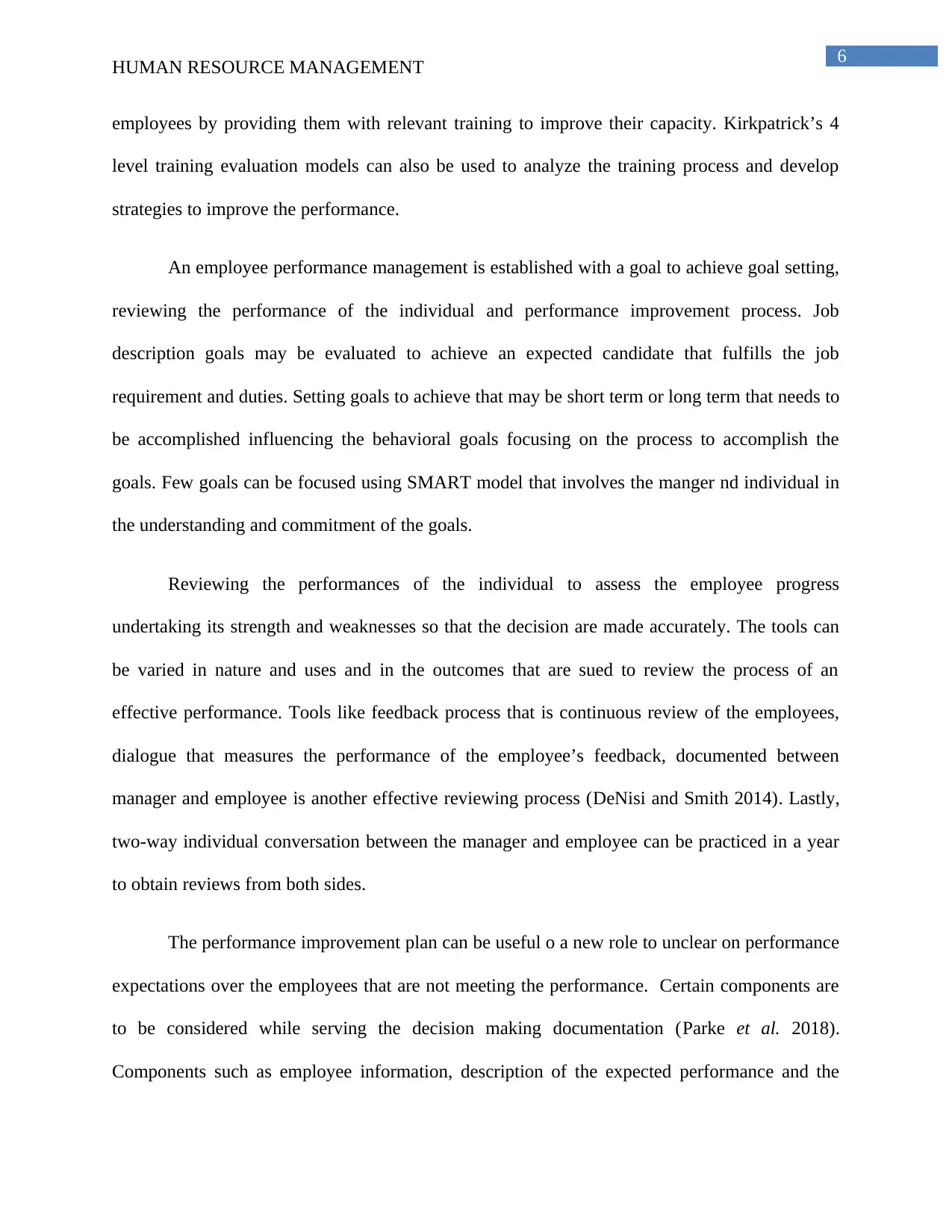
6
HUMAN RESOURCE MANAGEMENT
employees by providing them with relevant training to improve their capacity. Kirkpatrick’s 4
level training evaluation models can also be used to analyze the training process and develop
strategies to improve the performance.
An employee performance management is established with a goal to achieve goal setting,
reviewing the performance of the individual and performance improvement process. Job
description goals may be evaluated to achieve an expected candidate that fulfills the job
requirement and duties. Setting goals to achieve that may be short term or long term that needs to
be accomplished influencing the behavioral goals focusing on the process to accomplish the
goals. Few goals can be focused using SMART model that involves the manger nd individual in
the understanding and commitment of the goals.
Reviewing the performances of the individual to assess the employee progress
undertaking its strength and weaknesses so that the decision are made accurately. The tools can
be varied in nature and uses and in the outcomes that are sued to review the process of an
effective performance. Tools like feedback process that is continuous review of the employees,
dialogue that measures the performance of the employee’s feedback, documented between
manager and employee is another effective reviewing process (DeNisi and Smith 2014). Lastly,
two-way individual conversation between the manager and employee can be practiced in a year
to obtain reviews from both sides.
The performance improvement plan can be useful o a new role to unclear on performance
expectations over the employees that are not meeting the performance. Certain components are
to be considered while serving the decision making documentation (Parke et al. 2018).
Components such as employee information, description of the expected performance and the
HUMAN RESOURCE MANAGEMENT
employees by providing them with relevant training to improve their capacity. Kirkpatrick’s 4
level training evaluation models can also be used to analyze the training process and develop
strategies to improve the performance.
An employee performance management is established with a goal to achieve goal setting,
reviewing the performance of the individual and performance improvement process. Job
description goals may be evaluated to achieve an expected candidate that fulfills the job
requirement and duties. Setting goals to achieve that may be short term or long term that needs to
be accomplished influencing the behavioral goals focusing on the process to accomplish the
goals. Few goals can be focused using SMART model that involves the manger nd individual in
the understanding and commitment of the goals.
Reviewing the performances of the individual to assess the employee progress
undertaking its strength and weaknesses so that the decision are made accurately. The tools can
be varied in nature and uses and in the outcomes that are sued to review the process of an
effective performance. Tools like feedback process that is continuous review of the employees,
dialogue that measures the performance of the employee’s feedback, documented between
manager and employee is another effective reviewing process (DeNisi and Smith 2014). Lastly,
two-way individual conversation between the manager and employee can be practiced in a year
to obtain reviews from both sides.
The performance improvement plan can be useful o a new role to unclear on performance
expectations over the employees that are not meeting the performance. Certain components are
to be considered while serving the decision making documentation (Parke et al. 2018).
Components such as employee information, description of the expected performance and the
Paraphrase This Document
Need a fresh take? Get an instant paraphrase of this document with our AI Paraphraser
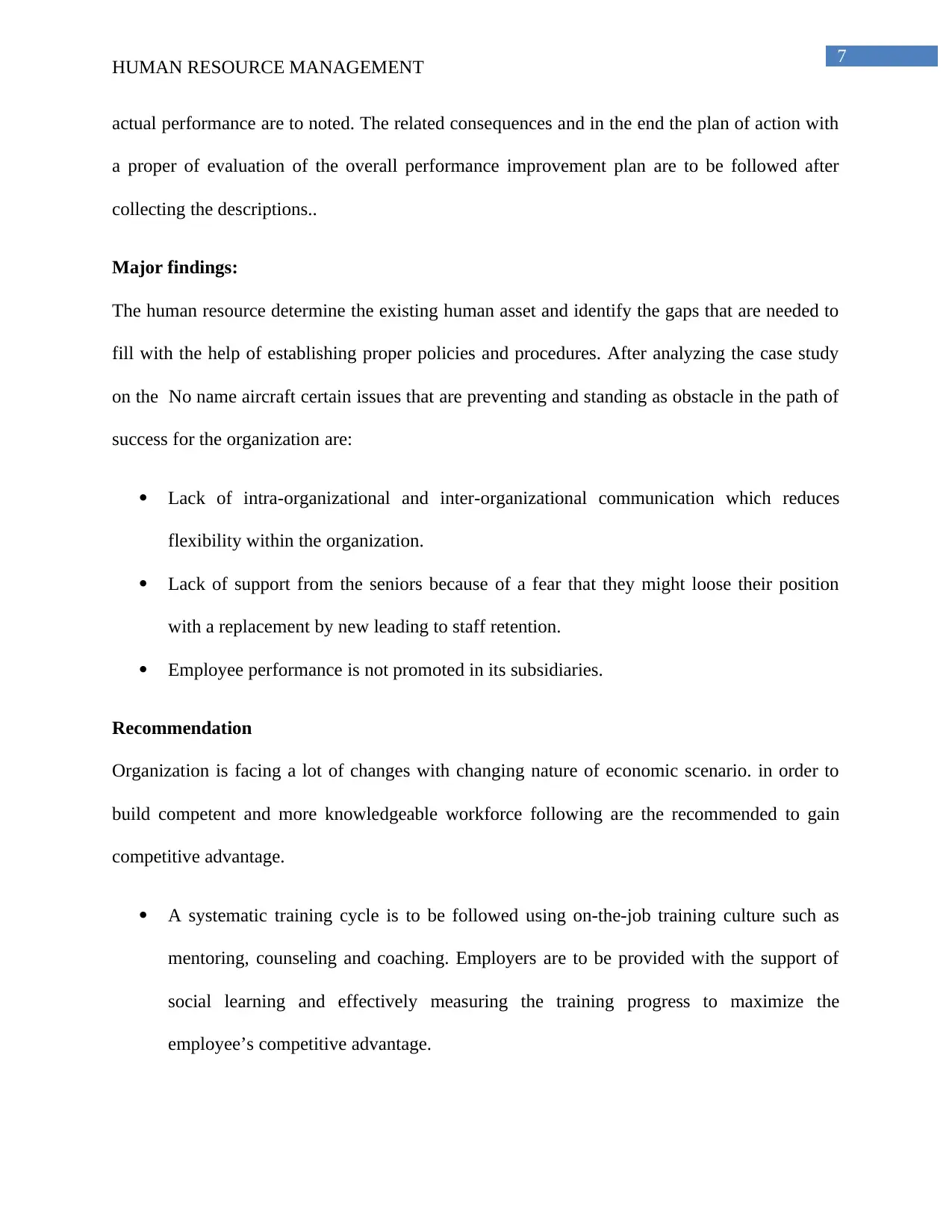
7
HUMAN RESOURCE MANAGEMENT
actual performance are to noted. The related consequences and in the end the plan of action with
a proper of evaluation of the overall performance improvement plan are to be followed after
collecting the descriptions..
Major findings:
The human resource determine the existing human asset and identify the gaps that are needed to
fill with the help of establishing proper policies and procedures. After analyzing the case study
on the No name aircraft certain issues that are preventing and standing as obstacle in the path of
success for the organization are:
Lack of intra-organizational and inter-organizational communication which reduces
flexibility within the organization.
Lack of support from the seniors because of a fear that they might loose their position
with a replacement by new leading to staff retention.
Employee performance is not promoted in its subsidiaries.
Recommendation
Organization is facing a lot of changes with changing nature of economic scenario. in order to
build competent and more knowledgeable workforce following are the recommended to gain
competitive advantage.
A systematic training cycle is to be followed using on-the-job training culture such as
mentoring, counseling and coaching. Employers are to be provided with the support of
social learning and effectively measuring the training progress to maximize the
employee’s competitive advantage.
HUMAN RESOURCE MANAGEMENT
actual performance are to noted. The related consequences and in the end the plan of action with
a proper of evaluation of the overall performance improvement plan are to be followed after
collecting the descriptions..
Major findings:
The human resource determine the existing human asset and identify the gaps that are needed to
fill with the help of establishing proper policies and procedures. After analyzing the case study
on the No name aircraft certain issues that are preventing and standing as obstacle in the path of
success for the organization are:
Lack of intra-organizational and inter-organizational communication which reduces
flexibility within the organization.
Lack of support from the seniors because of a fear that they might loose their position
with a replacement by new leading to staff retention.
Employee performance is not promoted in its subsidiaries.
Recommendation
Organization is facing a lot of changes with changing nature of economic scenario. in order to
build competent and more knowledgeable workforce following are the recommended to gain
competitive advantage.
A systematic training cycle is to be followed using on-the-job training culture such as
mentoring, counseling and coaching. Employers are to be provided with the support of
social learning and effectively measuring the training progress to maximize the
employee’s competitive advantage.
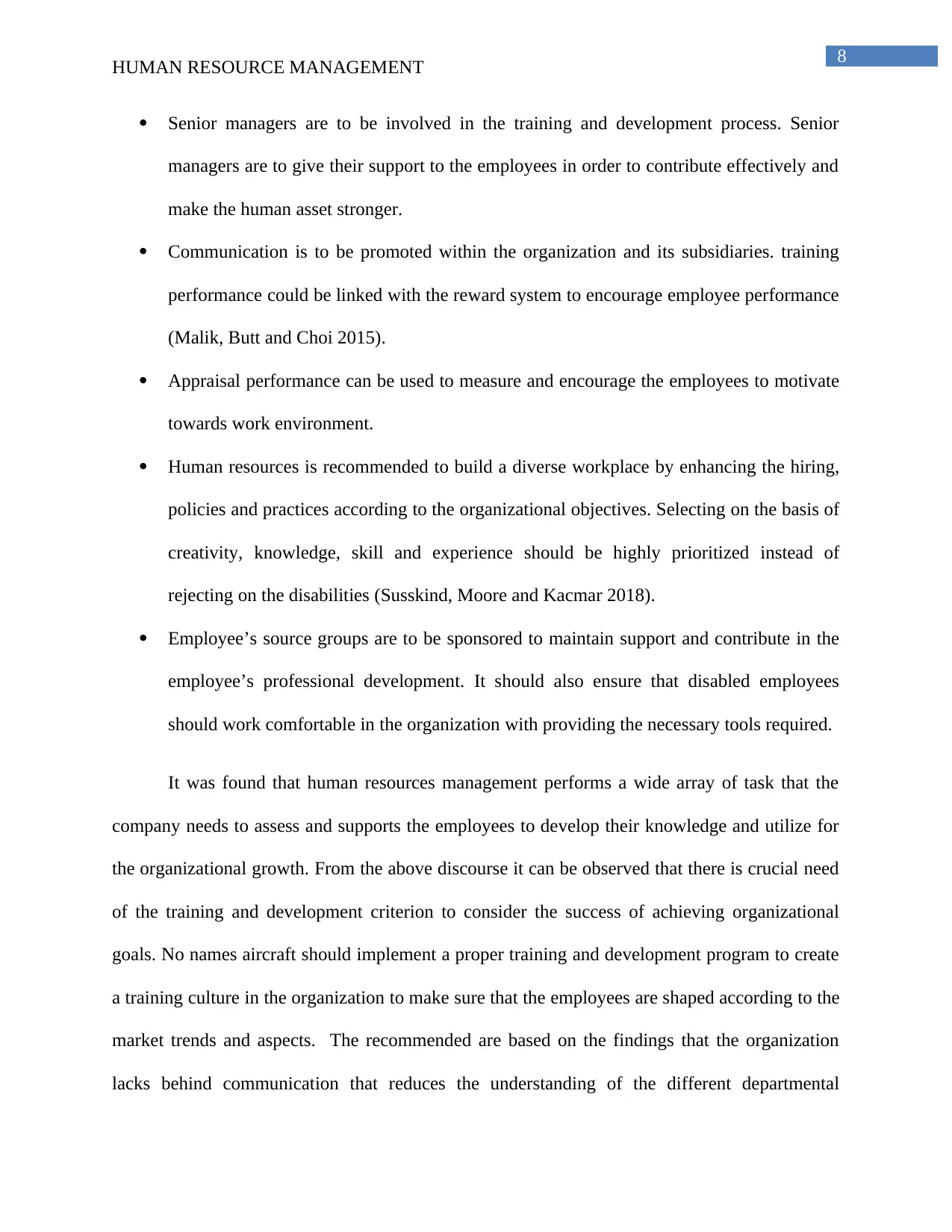
8
HUMAN RESOURCE MANAGEMENT
Senior managers are to be involved in the training and development process. Senior
managers are to give their support to the employees in order to contribute effectively and
make the human asset stronger.
Communication is to be promoted within the organization and its subsidiaries. training
performance could be linked with the reward system to encourage employee performance
(Malik, Butt and Choi 2015).
Appraisal performance can be used to measure and encourage the employees to motivate
towards work environment.
Human resources is recommended to build a diverse workplace by enhancing the hiring,
policies and practices according to the organizational objectives. Selecting on the basis of
creativity, knowledge, skill and experience should be highly prioritized instead of
rejecting on the disabilities (Susskind, Moore and Kacmar 2018).
Employee’s source groups are to be sponsored to maintain support and contribute in the
employee’s professional development. It should also ensure that disabled employees
should work comfortable in the organization with providing the necessary tools required.
It was found that human resources management performs a wide array of task that the
company needs to assess and supports the employees to develop their knowledge and utilize for
the organizational growth. From the above discourse it can be observed that there is crucial need
of the training and development criterion to consider the success of achieving organizational
goals. No names aircraft should implement a proper training and development program to create
a training culture in the organization to make sure that the employees are shaped according to the
market trends and aspects. The recommended are based on the findings that the organization
lacks behind communication that reduces the understanding of the different departmental
HUMAN RESOURCE MANAGEMENT
Senior managers are to be involved in the training and development process. Senior
managers are to give their support to the employees in order to contribute effectively and
make the human asset stronger.
Communication is to be promoted within the organization and its subsidiaries. training
performance could be linked with the reward system to encourage employee performance
(Malik, Butt and Choi 2015).
Appraisal performance can be used to measure and encourage the employees to motivate
towards work environment.
Human resources is recommended to build a diverse workplace by enhancing the hiring,
policies and practices according to the organizational objectives. Selecting on the basis of
creativity, knowledge, skill and experience should be highly prioritized instead of
rejecting on the disabilities (Susskind, Moore and Kacmar 2018).
Employee’s source groups are to be sponsored to maintain support and contribute in the
employee’s professional development. It should also ensure that disabled employees
should work comfortable in the organization with providing the necessary tools required.
It was found that human resources management performs a wide array of task that the
company needs to assess and supports the employees to develop their knowledge and utilize for
the organizational growth. From the above discourse it can be observed that there is crucial need
of the training and development criterion to consider the success of achieving organizational
goals. No names aircraft should implement a proper training and development program to create
a training culture in the organization to make sure that the employees are shaped according to the
market trends and aspects. The recommended are based on the findings that the organization
lacks behind communication that reduces the understanding of the different departmental
⊘ This is a preview!⊘
Do you want full access?
Subscribe today to unlock all pages.

Trusted by 1+ million students worldwide
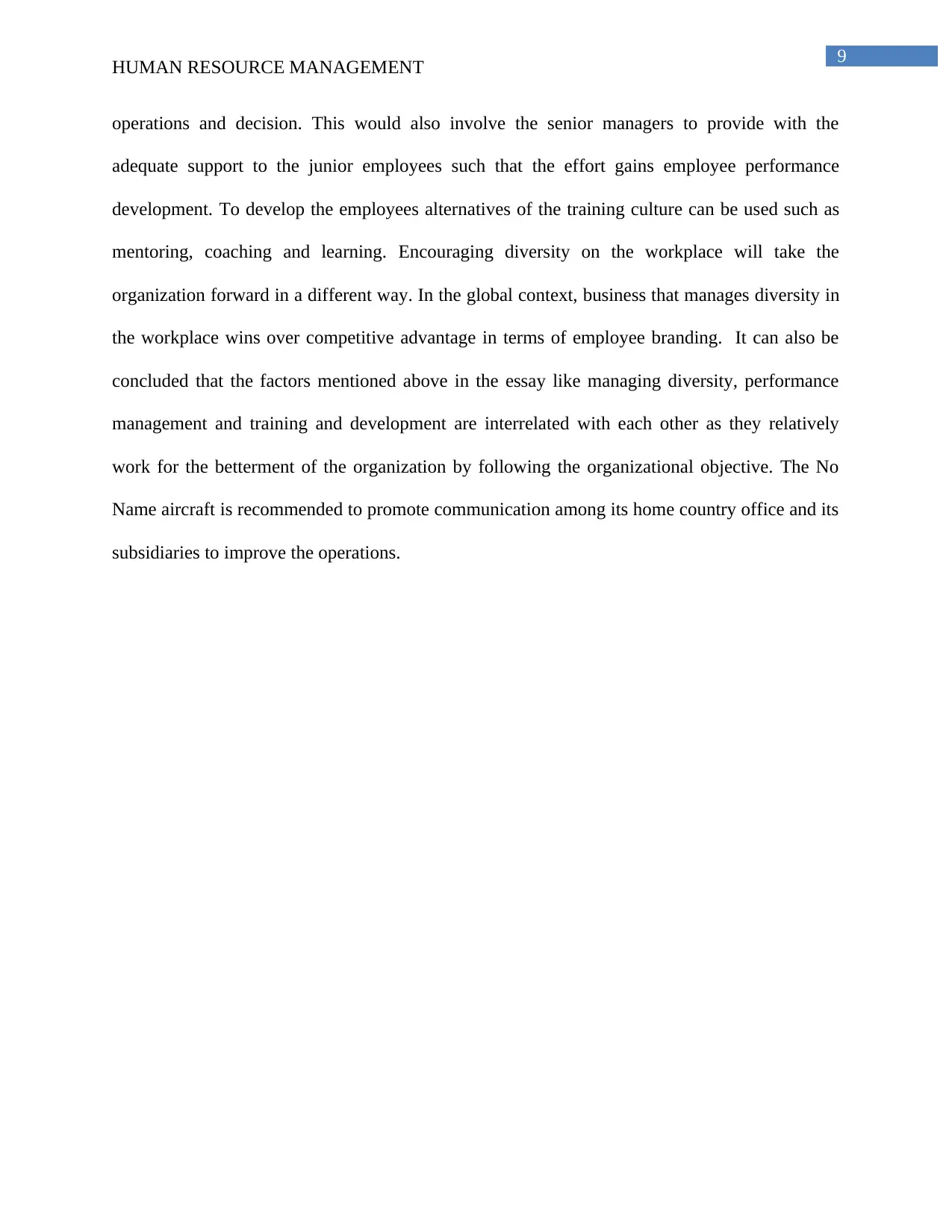
9
HUMAN RESOURCE MANAGEMENT
operations and decision. This would also involve the senior managers to provide with the
adequate support to the junior employees such that the effort gains employee performance
development. To develop the employees alternatives of the training culture can be used such as
mentoring, coaching and learning. Encouraging diversity on the workplace will take the
organization forward in a different way. In the global context, business that manages diversity in
the workplace wins over competitive advantage in terms of employee branding. It can also be
concluded that the factors mentioned above in the essay like managing diversity, performance
management and training and development are interrelated with each other as they relatively
work for the betterment of the organization by following the organizational objective. The No
Name aircraft is recommended to promote communication among its home country office and its
subsidiaries to improve the operations.
HUMAN RESOURCE MANAGEMENT
operations and decision. This would also involve the senior managers to provide with the
adequate support to the junior employees such that the effort gains employee performance
development. To develop the employees alternatives of the training culture can be used such as
mentoring, coaching and learning. Encouraging diversity on the workplace will take the
organization forward in a different way. In the global context, business that manages diversity in
the workplace wins over competitive advantage in terms of employee branding. It can also be
concluded that the factors mentioned above in the essay like managing diversity, performance
management and training and development are interrelated with each other as they relatively
work for the betterment of the organization by following the organizational objective. The No
Name aircraft is recommended to promote communication among its home country office and its
subsidiaries to improve the operations.
Paraphrase This Document
Need a fresh take? Get an instant paraphrase of this document with our AI Paraphraser
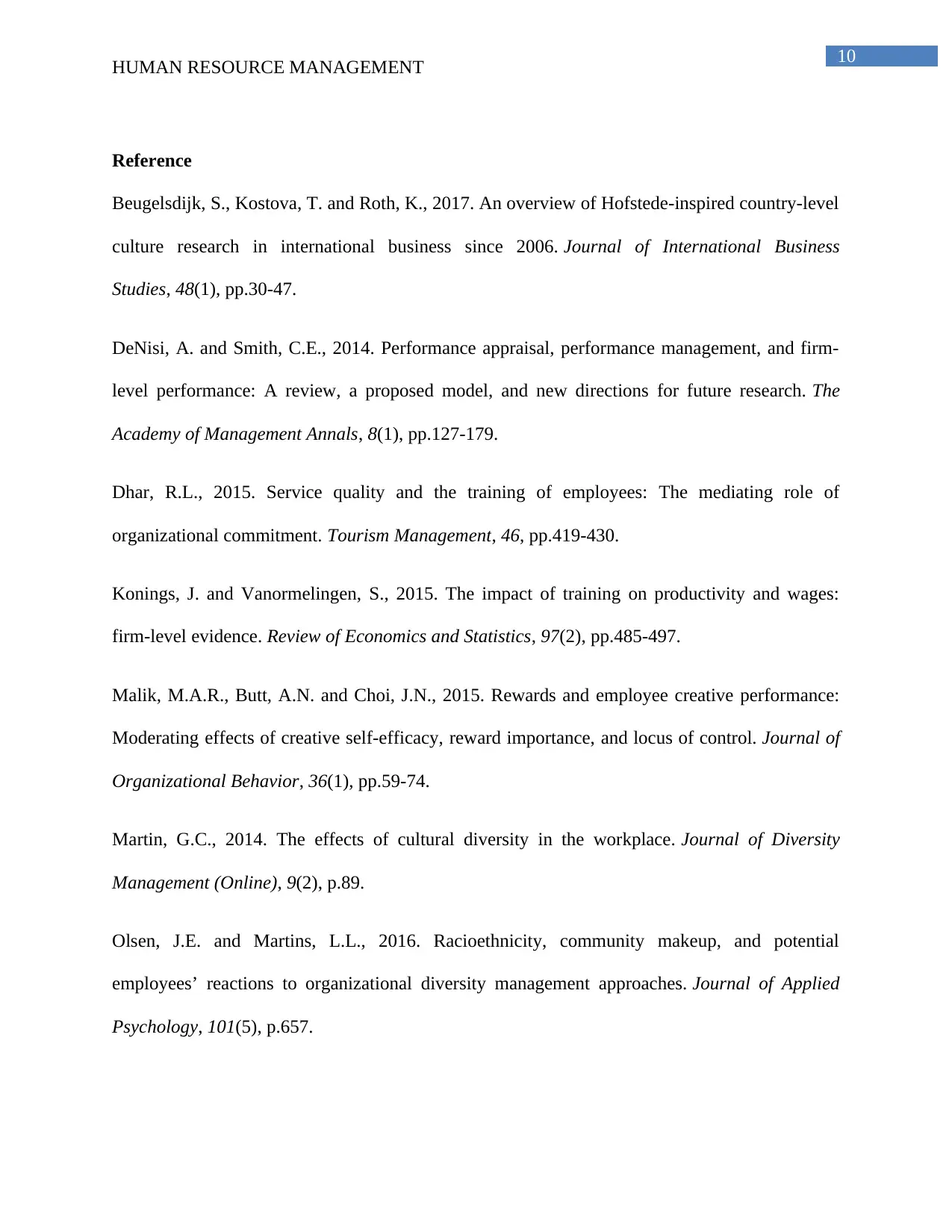
10
HUMAN RESOURCE MANAGEMENT
Reference
Beugelsdijk, S., Kostova, T. and Roth, K., 2017. An overview of Hofstede-inspired country-level
culture research in international business since 2006. Journal of International Business
Studies, 48(1), pp.30-47.
DeNisi, A. and Smith, C.E., 2014. Performance appraisal, performance management, and firm-
level performance: A review, a proposed model, and new directions for future research. The
Academy of Management Annals, 8(1), pp.127-179.
Dhar, R.L., 2015. Service quality and the training of employees: The mediating role of
organizational commitment. Tourism Management, 46, pp.419-430.
Konings, J. and Vanormelingen, S., 2015. The impact of training on productivity and wages:
firm-level evidence. Review of Economics and Statistics, 97(2), pp.485-497.
Malik, M.A.R., Butt, A.N. and Choi, J.N., 2015. Rewards and employee creative performance:
Moderating effects of creative self‐efficacy, reward importance, and locus of control. Journal of
Organizational Behavior, 36(1), pp.59-74.
Martin, G.C., 2014. The effects of cultural diversity in the workplace. Journal of Diversity
Management (Online), 9(2), p.89.
Olsen, J.E. and Martins, L.L., 2016. Racioethnicity, community makeup, and potential
employees’ reactions to organizational diversity management approaches. Journal of Applied
Psychology, 101(5), p.657.
HUMAN RESOURCE MANAGEMENT
Reference
Beugelsdijk, S., Kostova, T. and Roth, K., 2017. An overview of Hofstede-inspired country-level
culture research in international business since 2006. Journal of International Business
Studies, 48(1), pp.30-47.
DeNisi, A. and Smith, C.E., 2014. Performance appraisal, performance management, and firm-
level performance: A review, a proposed model, and new directions for future research. The
Academy of Management Annals, 8(1), pp.127-179.
Dhar, R.L., 2015. Service quality and the training of employees: The mediating role of
organizational commitment. Tourism Management, 46, pp.419-430.
Konings, J. and Vanormelingen, S., 2015. The impact of training on productivity and wages:
firm-level evidence. Review of Economics and Statistics, 97(2), pp.485-497.
Malik, M.A.R., Butt, A.N. and Choi, J.N., 2015. Rewards and employee creative performance:
Moderating effects of creative self‐efficacy, reward importance, and locus of control. Journal of
Organizational Behavior, 36(1), pp.59-74.
Martin, G.C., 2014. The effects of cultural diversity in the workplace. Journal of Diversity
Management (Online), 9(2), p.89.
Olsen, J.E. and Martins, L.L., 2016. Racioethnicity, community makeup, and potential
employees’ reactions to organizational diversity management approaches. Journal of Applied
Psychology, 101(5), p.657.
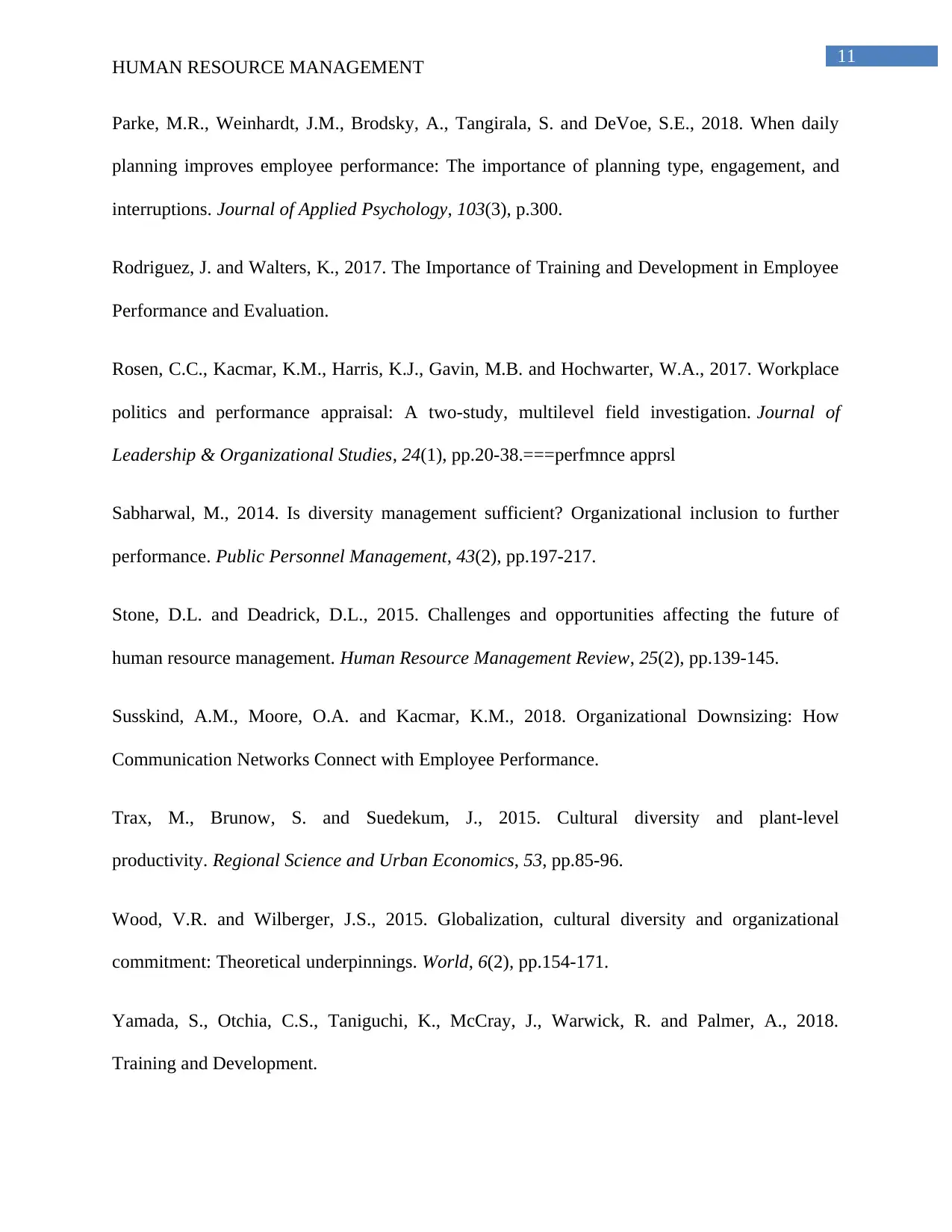
11
HUMAN RESOURCE MANAGEMENT
Parke, M.R., Weinhardt, J.M., Brodsky, A., Tangirala, S. and DeVoe, S.E., 2018. When daily
planning improves employee performance: The importance of planning type, engagement, and
interruptions. Journal of Applied Psychology, 103(3), p.300.
Rodriguez, J. and Walters, K., 2017. The Importance of Training and Development in Employee
Performance and Evaluation.
Rosen, C.C., Kacmar, K.M., Harris, K.J., Gavin, M.B. and Hochwarter, W.A., 2017. Workplace
politics and performance appraisal: A two-study, multilevel field investigation. Journal of
Leadership & Organizational Studies, 24(1), pp.20-38.===perfmnce apprsl
Sabharwal, M., 2014. Is diversity management sufficient? Organizational inclusion to further
performance. Public Personnel Management, 43(2), pp.197-217.
Stone, D.L. and Deadrick, D.L., 2015. Challenges and opportunities affecting the future of
human resource management. Human Resource Management Review, 25(2), pp.139-145.
Susskind, A.M., Moore, O.A. and Kacmar, K.M., 2018. Organizational Downsizing: How
Communication Networks Connect with Employee Performance.
Trax, M., Brunow, S. and Suedekum, J., 2015. Cultural diversity and plant-level
productivity. Regional Science and Urban Economics, 53, pp.85-96.
Wood, V.R. and Wilberger, J.S., 2015. Globalization, cultural diversity and organizational
commitment: Theoretical underpinnings. World, 6(2), pp.154-171.
Yamada, S., Otchia, C.S., Taniguchi, K., McCray, J., Warwick, R. and Palmer, A., 2018.
Training and Development.
HUMAN RESOURCE MANAGEMENT
Parke, M.R., Weinhardt, J.M., Brodsky, A., Tangirala, S. and DeVoe, S.E., 2018. When daily
planning improves employee performance: The importance of planning type, engagement, and
interruptions. Journal of Applied Psychology, 103(3), p.300.
Rodriguez, J. and Walters, K., 2017. The Importance of Training and Development in Employee
Performance and Evaluation.
Rosen, C.C., Kacmar, K.M., Harris, K.J., Gavin, M.B. and Hochwarter, W.A., 2017. Workplace
politics and performance appraisal: A two-study, multilevel field investigation. Journal of
Leadership & Organizational Studies, 24(1), pp.20-38.===perfmnce apprsl
Sabharwal, M., 2014. Is diversity management sufficient? Organizational inclusion to further
performance. Public Personnel Management, 43(2), pp.197-217.
Stone, D.L. and Deadrick, D.L., 2015. Challenges and opportunities affecting the future of
human resource management. Human Resource Management Review, 25(2), pp.139-145.
Susskind, A.M., Moore, O.A. and Kacmar, K.M., 2018. Organizational Downsizing: How
Communication Networks Connect with Employee Performance.
Trax, M., Brunow, S. and Suedekum, J., 2015. Cultural diversity and plant-level
productivity. Regional Science and Urban Economics, 53, pp.85-96.
Wood, V.R. and Wilberger, J.S., 2015. Globalization, cultural diversity and organizational
commitment: Theoretical underpinnings. World, 6(2), pp.154-171.
Yamada, S., Otchia, C.S., Taniguchi, K., McCray, J., Warwick, R. and Palmer, A., 2018.
Training and Development.
⊘ This is a preview!⊘
Do you want full access?
Subscribe today to unlock all pages.

Trusted by 1+ million students worldwide
1 out of 14
Related Documents
Your All-in-One AI-Powered Toolkit for Academic Success.
+13062052269
info@desklib.com
Available 24*7 on WhatsApp / Email
![[object Object]](/_next/static/media/star-bottom.7253800d.svg)
Unlock your academic potential
Copyright © 2020–2025 A2Z Services. All Rights Reserved. Developed and managed by ZUCOL.




